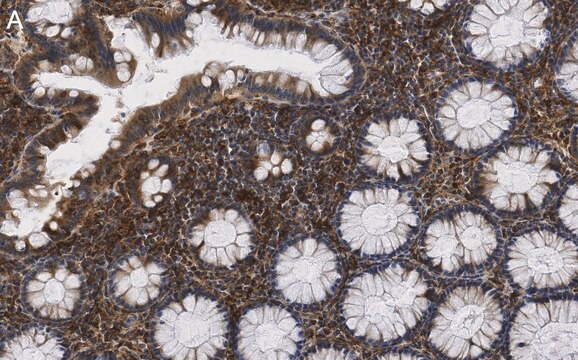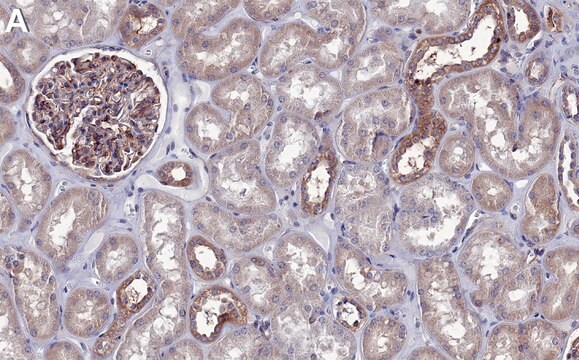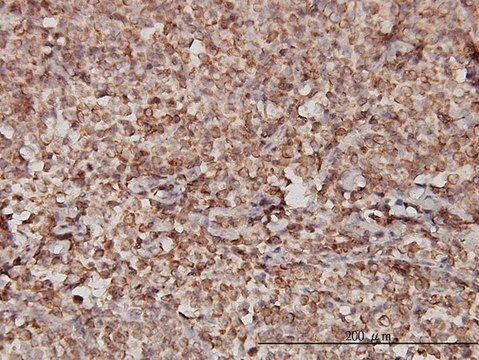AB6004
Anti-MT1-MMP Antibody, hinge region
from rabbit, purified by affinity chromatography
别名:
MT-MMP 1, Membrane-type matrix metalloproteinase 1, Membrane-type-1 matrix metalloproteinase, matrix metallopeptidase 14 (membrane-inserted), matrix metalloproteinase 14, matrix metalloproteinase 14 (membrane-inserted), membrane type 1 metalloprotease
登录查看公司和协议定价
所有图片(3)
About This Item
分類程式碼代碼:
12352203
eCl@ss:
32160702
NACRES:
NA.41
推荐产品
生物源
rabbit
品質等級
抗體表格
affinity isolated antibody
抗體產品種類
primary antibodies
無性繁殖
polyclonal
純化經由
affinity chromatography
物種活性
human, rat
技術
immunohistochemistry: suitable (paraffin)
western blot: suitable
UniProt登錄號
運輸包裝
wet ice
目標翻譯後修改
unmodified
基因資訊
human ... MMP14(4323)
一般說明
Matrix metalloproteinases (MMPs) are a family of secreted and membrane-bound zinc endopeptidases. Collectively, these enzymes degrade the components of extracellular matrix, including fibrillar and non-fibrillar collagens, fibronectin, laminin and basement membrane glycoproteins. MMPs play an important role in wound healing, apoptosis, bone elongation, embryo development, angiogenesis, cancer metastases, and tissue remodeling within many disease states.
Most MMP′s are secreted as inactive proproteins which are activated when cleaved by extracellular proteinases. However, MT1-MMP (MMP-14) is a member of the membrane-type subfamily. Each member of this subfamily contains a potential transmembrane domain suggesting that these proteins are expressed at the cell surface rather than secreted. MT1-MMP is capable of mediating pericellular proteolysis of extracellular matrix components and is therefore thought to be an important molecular tool for cellular remodeling of the surrounding matrix. This protein also activates MMP2 protein, and this activity may be involved in tumor invasion.
Most MMP′s are secreted as inactive proproteins which are activated when cleaved by extracellular proteinases. However, MT1-MMP (MMP-14) is a member of the membrane-type subfamily. Each member of this subfamily contains a potential transmembrane domain suggesting that these proteins are expressed at the cell surface rather than secreted. MT1-MMP is capable of mediating pericellular proteolysis of extracellular matrix components and is therefore thought to be an important molecular tool for cellular remodeling of the surrounding matrix. This protein also activates MMP2 protein, and this activity may be involved in tumor invasion.
特異性
Predicted to cross react with mouse, (95% sequence homology) and monkey chimpanzee, canine and bovine (100% sequence homology). Reactivity with other species has not been tested.
The antibody recognizes human and rat MT1-MMP. It does not cross react with MMP-1, MMP-2, MMP-8, MMP-9, and MMP-13.
免疫原
KLH conjugated synthetic peptide selected from the hinge region of human MT1-MMP.
應用
Detect MT1-MMP using this Anti-MT1-MMP Antibody, hinge region validated for use in WB, IH(P).
品質
Evaluated on a representative lot by Western blot on rat lung lysate using Anti-MT1-MMP.
標靶描述
~ 65 kDa
聯結
Replaces: AB815
分析報告
Control
Rat lung lysate.
Rat lung lysate.
其他說明
Concentration: Please refer to the Certificate of Analysis for the lot-specific concentration.
未找到合适的产品?
试试我们的产品选型工具.
儲存類別代碼
12 - Non Combustible Liquids
水污染物質分類(WGK)
WGK 1
閃點(°F)
Not applicable
閃點(°C)
Not applicable
Mario A Cepeda et al.
Molecular cancer, 15(1), 65-65 (2016-10-21)
Membrane Type-1 Matrix Metalloproteinase (MT1-MMP) is a multifunctional protease implicated in metastatic progression ostensibly due to its ability to degrade extracellular matrix (ECM) components and allow migration of cells through the basement membrane. Despite in vitro studies demonstrating this principle
Yuko Matsuura-Hachiya et al.
Biochemistry and biophysics reports, 4, 180-186 (2015-09-21)
The renin-angiotensin system is known to be involved in skin remodeling and inflammation. Previously, we reported that ultraviolet B (UVB) irradiation enhanced angiotensin-converting enzyme (ACE) expression and angiotensin II levels in hairless mouse skin, and an ACE inhibitor, enalapril maleate
Survivin, MMP-2, MT1-MMP, and TIMP-2: their impact on survival, implantation, and proliferation of endometriotic tissues.
Ambrogio P Londero,Angelo Calcagno,Tiziana Grassi,Stefania Marzinotto,Maria Orsaria et al.
Virchows Archiv null
Membrane-type-3 matrix metalloproteinase (MT3-MMP) functions as a matrix composition-dependent effector of melanoma cell invasion.
Tatti, O; Arjama, M; Ranki, A; Weiss, SJ; Keski-Oja, J; Lehti, K
Testing null
The podosome marker protein Tks5 regulates macrophage invasive behavior.
Karen L Burger,Amanda L Davis,Scott Isom,Nilamadhab Mishra,Darren F Seals
Cytoskeleton (Hoboken, N.J.) null
我们的科学家团队拥有各种研究领域经验,包括生命科学、材料科学、化学合成、色谱、分析及许多其他领域.
联系技术服务部门






